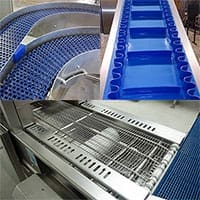Category: News
Over the past 25 years the variety of conveyor belting types has grown exponentially. While this choice allows conveyor manufactures greater choice to better specify belting to suit the products they are asked to handle. The array of belts can appear daunting to the uninitiated. Below we will discuss some of the different belting options available and look at their main characteristics and their suitability for specific products and applications.
Fabric belts
Manufactured from a base fabric these belts are topped with a variety of plastic materials which give the belt its characteristic look. Physical characteristics differ from material to material with some offering low friction surfaces where products need to slide or more grippy options for incline or decline applications. Fabric belts are highly popular in the bakery and dairy industries with the high levels of hygiene they offer, particularly with fully sealed options available. Fabric belts are straight running and drive is via a driven roller beneath the belt. The integration of built-in flights or side guides can make these belts suitable for granular products as well as more solid products. Small transfer diameters are possible with fabric belting which makes them suitable for small products like biscuits. If your product needs to go around a bend or a dedicated turn unit with fabric belts, there are options available.
Wire Belts
Wire belts as the name suggests are manufactured from woven or interlocking strands of stainless-steel wire. Different pitches and wire gauges are available making them suitable for a wide range of applications. Wire belts offer high levels of hygiene and are easy to clean having a high percentage of open area. Wire belts are perfectly suited to high temperate applications in grills, fryers and ovens. They are also perfect for applications where the product needs to drain such as after a fryer or under glazing or enrobing units. Wire belts are positively driven with driven sprockets and small transfer diameters are possible, particularly with the smaller pitch belts. Wire belts are either straight running or for curves belts of a fixed turn radius are available.
Modular Plastic Belts
The range of modular plastic belts on the market nowadays is vast, with belts to suit the majority of products. Available as straight running, side-flexing or fixed pitch turn these belts are manufactured from plastic modules linked together with pins. These belts are positively driven with sprockets that mesh with the belt modules. The module design for each manufacturers belt is unique to them so components and sprockets are not interchangeable. For this reason, it may be worth considering only using one type of modular plastic belt on site so you can minimise your spares stock holding.
Early concerns over the cleanability of these belts has largely dispersed since manufacturers have sought to make their products easier to clean.
Straight running belts are available in a range of pitches from ½” to 2”, the smaller pitch belts are suitable for bakery applications with small transfer diameters. The larger pitch belts are more suited to packing halls for handling crates and cartons. Some small pitch belts have an open area of nearly 50% which makes them comparable to wire belts for some applications.
Side-flexing belts sit in the middle of the size range which means they have larger transfer diameters making them less suitable for small products. But their flexible nature allows them to turn corners with long straights which reduces the number of transfers needed. The addition of high friction modules and flights also makes these belts suitable for incline and decline applications.
Points to consider when choosing a belt.
There are many factors to consider when choosing conveyor belts, as not all will be suitable for your application and a mixture of types will be necessary, particularly through different stages of your manufacturing process.
When choosing a belt, first consider the product, the size, weight, and throughput. Are you handling unwrapped product, is it in a carrier or are you handling packaged products in cartons or crates? How stable is your product? Flat rectangular products transfer between conveyors better than top heavy pots with narrow bases.
The next thing to consider is the production environment, do you need to wind in and out of existing machinery, or change levels. Are you working in a very hot or a chilled environment? Do you need to move product on the belt, for example merging lanes or does the product need to be stay in a set position?
Once you understand nature of your product and the processing requirements you can begin to focus down the choice of belting.
Conclusion
While the expansion of belting choice can at first seem daunting, with a little knowledge and consideration of your product you can focus down your search to find the perfect match for your needs.
This article was originally published in Food Processing magazine, March 2021
